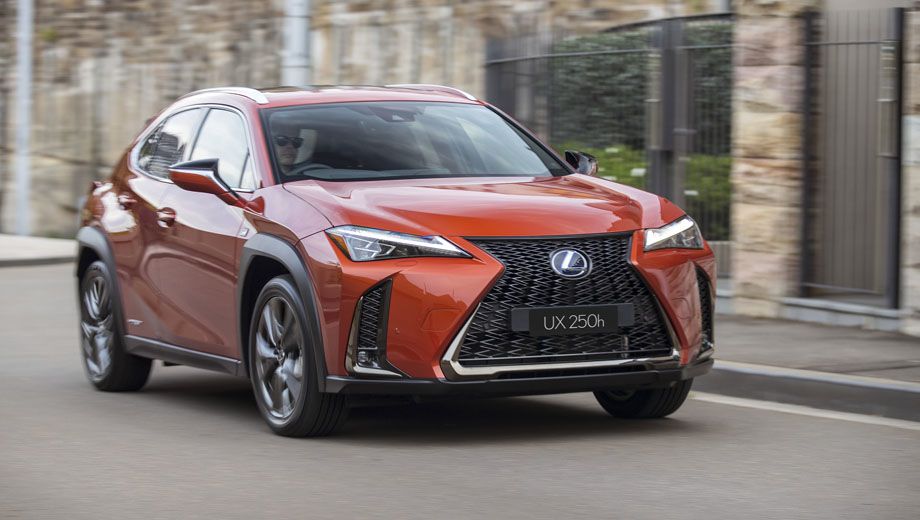What we’re driving: Lexus UX 250h F Sport
What it costs: Lexus UX from around $45,450 (our Lexus UX 250h 2WD F Sport test drive sat at $56,950)
Why we’re driving it: The Japanese luxury brand’s newest model is also its first foray into the booming compact-luxury-crossover segment. Entry-level UX 200 variants were launched here in late 2018 while the hybrid UX 250h variants arrived in only mid-January.
The name UX is a derivation of the concept keywords “Urban + X-over (crossover)” and Lexus has designed the car to attract a new breed of young buyers to the brand.
There are three core UX models and eight trim grades, starting with a conventional 2.0-litre four-cylinder petrol in the 126kW UX 200 2WD ($44,450 to $53,450), rising to a 131kW self-charging hybrid in the UX 250h 2WD ($47,950 to $56,950), and onto same hybrid system driving all four wheels in the UX 250h AWD UX ($61,000 to $61,450).
Prestige car buyers looking at this size vehicle and price point should also be considering rival offerings such as the Audi Q2, BMW X1, Mercedes-Benz GLA and the Infiniti QX30.
On the outside: The production version’s exterior styling remains is surprisingly true to the 2016 Concept, with its coupé-like roofline and dramatically flared 4x4-style wheelarches, all wrapped in intricately sculpted bodywork that presents as an unconventional mix of styles.
Up front, there’s the signature Lexus spindle grille, which brings to my mind the image of a Samurai warrior’s full-face armour. This is flanked by distinctive headlamps topped with daytime running lights that look like the brooding brow of the aforementioned warrior. At the rear a sequence of LEDs run the full-width of the car to create a distinctive night-time signature.
The F Sport package we’re testing is also available on the UX 200 and adds 18-inch alloys, an exclusive grille treatment plus unique front and rear bumpers. Our review car also boasted a moon-roof costing $2500, and Khaki Metal-coloured premium paint costing $1500, for an all up RRP of $60,950.
Under the bonnet: The base engine for the UX range is a new 2.0-litre in-line four-cylinder, paired with two electric motor-generators in the hybrid models.
The hybrid system is fairly seamless at all speeds and you rarely have a sense of the systems switching, aside from a slight increase in engine noise or a pleasantly unexpected kick in the pants when the throttle is nailed .
Interestingly, while it may not be the range-topper, the UX 250h tested here is both the performance and the fuel-efficiency leader of the lineup, with a claimed 0-100km/h sprint of 8.5 seconds and combined cycle economy from 4.5 litres/100km.
On the inside: Opening the F Sport-enhanced 250h's door reveals a tastefully trimmed cabin featuring lashings of leather, including on its dash, its sculpted electric front seats, steering wheel and shift knob.
The design is a polarising mix of angles and shapes that shouts "edgy and modern" if not altogether fluid and cohesive.
There’s an 8-inch display screen for the sat nav and audio but we struck trouble when it came time to input an address and sync a phone, as it’s all controlled by a less-than-intuitive touch pad system which Lexus says is designed to mimic common mobile phone operations, such as double tapping and flicking but which bamboozled me in a way my iPhone never has.
While standard UX models get three drive modes (normal, economy and sport), the F Sport variants boast additional Sport + and Custom settings, all selected by a stubby stalk that protrudes from the side of the main instrument panel.
Selecting Sport or Sport+ brings the UX to life, with the digitally rendered instrument cluster glowing orange and then an angry red as revs climb.
Interior space is on par for the class, which means good front-seat accommodation but limited legroom for anyone other than kids in the rear.
On the road: The UX is the first model to be built on a new C-segment Lexus Global Architecture which promises a low centre of gravity and highly rigid body structure. In the case of this hybrid model, the low centre of gravity is further enhanced by placement of the nickel metal-hydride battery and cooling system under the rear seat.
Our sports-oriented UX felt decently responsive through its electrically-assisted tiller, and the integration of cornering assist in its stability control system helps minimise understeer in vigorous cornering. The overall impression across a mixed range of driving conditions is that it feels to have good levels of grip, is decently nimble and capable of rising to the whip when required.
In summary: The UX 250h 2WD F Sport is a highly competent and well-rounded machine with great tech, excellent fuel efficiency and a list of standard features that will cost many thousands more fitted to a German rivals.
In the Lexus tradition it’s extremely very well built, nicely finished and positioned at a price point that should open the brand up to the younger buyers it seeks. Perhaps the target market will relish the Game Boy challenge of its human-machine interface, but I found it unnecessarily complex.
The UX stops short of being a really riveting driving machine, but it does an admirable job of emulating the spirit of a new-age warm hatch, albeit one with the buff looks of a crossover.








Hi Guest, join in the discussion on Test drive: Lexus UX 250h F Sport